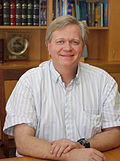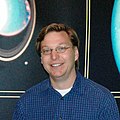Recipients
Source: University of Arizona
| Year | Recipient | Award Citation | |
|---|---|---|---|
| 1989 |  | Robert Kirshner [3] | For studies of supernovae, supernova remnants, and the large-scale distribution of galaxies |
| 1990 |  | Ken Freeman [4] | TBD |
| 1992 | John Huchra [5] | For surveys that led to the discovery of large-scale structure in the distribution of galaxies | |
| 1993 | Nick Scoville | TBD | |
| 1994 |  | Wendy Freedman [6] | For a decade of fundamental contributions to the areas of the extragalactic distance scale and the stellar populations of galaxies |
| 1996 | J. Anthony Tyson [7] | In recognition of his use of new technologies to make pioneering contributions in observational cosmology | |
| 1998 |  | John C. Mather [8] | For the conception, design, and execution of a seminal cosmological observation, the measurement of the infrared background with the COBE satellite |
| 1999 |  | Bohdan Paczyński [9] | For his theories of gamma-ray bursts and for his work on microlensing |
| 2001 |  | Ewine van Dishoeck | For her comprehensive attack on the problem of chemical evolution of star-forming regions [10] |
| 2002 |  | Geoffrey Marcy | For his pioneering work on low-mass stars, and for his discovery of more than fifty planets orbiting other stars [11] |
| 2004 |  | Lyman Page | For his decade-long series of state-of-the-art experiments aimed at the discovery and characterization of degree-scale temperature anisotropies of the cosmic microwave background radiation [12] |
| 2005 |  | Brian P. Schmidt | For using observations of Type Ia supernovae to discover that the Universe's expansion is accelerating [13] |
| 2007 | Andrea Ghez | For her use of speckle and AO and IR imaging to further our understanding of the dark object in the Galactic Center (the supermassive black hole) and for her work on star formation and evolution of pre-main-sequence objects [14] | |
| 2008 |  | Mike Brown | For his outstanding research and lasting contribution to astronomy through the characterization of the outer solar system and the discovery of objects comparable to Pluto [15] [16] |
| 2010 |  | J. Davy Kirkpatrick | For his outstanding research and lasting contribution to astronomy through the discovery and characterization of the lowest mass stars and brown dwarfs [17] |
| 2012 | Pieter van Dokkum | For his studies of the evolution of the most massive galaxies over cosmic time | |
| 2014 | Alice Shapley | For her contributions to the study of how galaxies form in the early universe | |
| 2015 | Vasily Belokurov | For his discoveries of structures in the Milky Way through data-mining of large surveys | |
| 2019 | Jenny Green | For her work on black holes | |